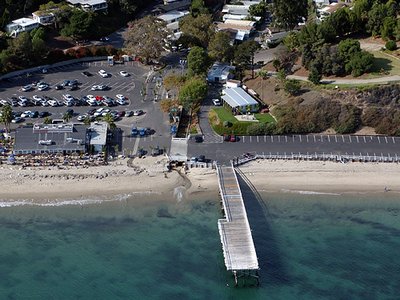 Research Areas > Beach Water Quality > Upper Santa Monica Bay Microbial Source Tracking
Research Areas > Beach Water Quality > Upper Santa Monica Bay Microbial Source Tracking
Project: Upper Santa Monica Bay Microbial Source Tracking
Background and Objectives
Beaches at the mouths of many urban drainage systems in Southern California have fecal indicator bacteria levels that exceed ocean water quality (AB411) standards. A first step in remediating these beaches is identifying the sources of the bacteria. A number of new techniques, mostly based on genetic fingerprinting, have been developed to assist with source identification. However, a framework for how to use these methods in combination with traditional surveys does not yet exist in southern California.
Ramirez Creek (RC) and Escondido Creek (EC), located in the City of Malibu and Los Angeles County, are two of many creeks that run from the hills above Malibu into Santa Monica Bay. Beaches at the mouths of RC and EC have shown high levels of indicator bacteria in previous years. The goal of this project was to identify the primary bacterial sources in RC and EC and assess whether the two creeks are significant contributors to high levels of bacteria on beaches. A secondary goal was to use RC and EC as prototypes to develop a source tracking framework that is transferable to other locations.

The outlet of Ramirez Creek is located adjacent to Paradise Cove beach in Malibu, within Santa Monica Bay (image courtesy Heal the Bay).
Status
This project was initiated in 2007 and completed in 2010.
Methods
This study involved four phases of sampling. The first was a traditional survey to determine if any portions of the watershed appeared to be large sources of indicator bacteria. The second phase involved using two relatively inexpensive methods (optical brighteners and Bacteroides human marker) for determining which, if any, areas in the watershed have bacteria that are of human origin. Based on results from the first two phases, the planned third phase involved more targeted geographical sampling to identify individual sources. If these three phases failed to identify the source, the fourth phase would have involved library-based genetic source identification methods to identify the predominant animal type(s) contributing the fecal material. This is generally used as a last phase because it is the most expensive, and most scientifically uncertain, but is an alternative when geographic-based sampling is ineffective.
Findings
Enterococcus exceedances at Paradise Cove beach (adjacent to RC) and Escodido Beach (adjacent to EC) appear to have resolved, as there were fewer beach postings during the project time period. Improvement in beach water quality may be related to a decrease in rainfall and urban runoff flows, installation of an onsite wastewater treatment facility at Paradise Cove, and public notification of ongoing efforts to reduce bacterial pollution. Work to track bacteria sources will resume pending any re-occurrence of beach postings.
Partners
Los Angeles County Department of Public Works
Heal the Bay
Malibu Bacteria Source Identification Task Force
This page was last updated on: 7/2/2014